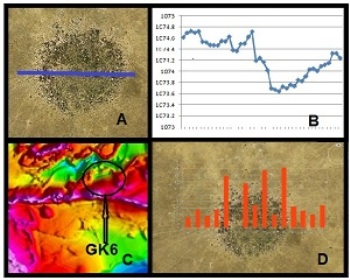Jun 12 2013
Pangolin Diamonds Corp., (the "Company" or "Pangolin") is pleased to announce it has completed a detailed aeromagnetic and radiometric survey over its 100% owned Jwaneng South Project in Botswana.
 This figure depicts the GK6 anomaly highlights: (A) 1.4 km diameter geobotanical feature with east-west gravity line location (B) Gravity profile of east-west line across (C) Jwaneng South aeromagnetic survey indicating location (D) Anomalous vanadium trace element profile across the geobotanical feature
This figure depicts the GK6 anomaly highlights: (A) 1.4 km diameter geobotanical feature with east-west gravity line location (B) Gravity profile of east-west line across (C) Jwaneng South aeromagnetic survey indicating location (D) Anomalous vanadium trace element profile across the geobotanical feature
The survey of the 799 km2 project area, located on the Archaean Kaapvaal Craton, identified multiple large aeromagnetic anomalies commonly associated with kimberlites. In addition, a ground gravity survey was completed over the 1.4 km diameter GK6 target.
The Jwaneng South Project is close to De Beers' Jwaneng Mine, the richest diamond mine in the world by value (http://www.debeersgroup.com/Operations/Mining/Mining-Operations/Debswana/Jwaneng).
The findings include:
- Several large aeromagnetic anomalies commonly associated with kimberlite intrusions occurring within the project area.
- A 1.4 km diameter geobotanical anomaly, identified as "GK6", is directly associated with an aeromagnetic anomaly. The geobotanical anomaly over GK6 is similar to that associated with the 350m diameter Orapa BK3 kimberlite.
- An isolated gravity low over the eastern part of GK6 aeromagnetic anomaly is similar to gravity lows associated with the nearby Jwaneng Mine kimberlites and other kimberlites in this field.
- Enzyme-leach trace element results are consistent with orientation trace element results over known diamondiferous kimberlites from the Jwaneng kimberlite field. The results come from an independent analysis of samples by Activation Laboratories Ltd. of Ancaster, Ont.
- The discovery of kimberlite indicator garnets in soil samples.
The GK6 anomaly highlights are shown in the figure below:
- 1.4 km diameter geobotanical feature with east-west gravity line location
- Gravity profile of east-west line across
- Jwaneng South aeromagnetic survey indicating location
- Anomalous vanadium trace element profile across the geobotanical feature
To view the figure associated with this press release, please visit the following link: http://media3.marketwire.com/docs/pang10610.pdf
Dr Leon Daniels, B.Sc., Ph.D., Chairman of the Board of Pangolin, stated: "Based on these positive results, we have demonstrated the Company possesses multiple high potential project areas for discovering new kimberlites. We have prioritized drilling in the Jwaneng South Project area and will commence in Q3 of 2013. The recently concluded aeromagnetic, radiometric and gravity surveys move us closer to completion of a National Instrument 43-101 Technical Report for this Project."
The Jwaneng South aeromagnetic survey data indicates a range of aeromagnetic anomalies, both magnetic positive and magnetic negative. The figure below shows a 650 meter wide positive anomaly and a 1,000 meter wide negative anomaly.
To view the figure associated with this press release, please visit the following link: http://media3.marketwire.com/docs/pang20610.pdf
Separately, Pangolin confirmed that drilling continues at its Tsabong North Project. In addition, exploration activities continue at Pangolin's Malatswae and Mmadinare Projects.
(A map of the project areas can be found at http://pangolindiamondscorp.com/pdfs/PDC-Property-Map-Nov-2012.pdf).
Details of the airborne survey work
Xcalibur Airborne Geophysics (XAG) from South Africa performed a detailed high resolution airborne geophysical survey. XAG used an Air Tractor system for the execution of this survey.
- The survey consisted of a total of approximately 6,752 line-km.
- The nominal survey height was 25 meters above ground level.
- The survey was flown at 100 meter line-spacing with tie-line spacing of 1,000 meters.
- Survey groundspeed was approximately 240 km/hr resulting in a magnetic sample spacing of approximately 3.5 meters.
- Line direction was 0°/180° in the UTM35S system.
- Tie-line direction was 90°/270° in the UTM35S system
Magnetic data was collected with two Geometrics G823 Cesium Vapor sensors. The data was recorded at a resolution of 0.001nT and the rate of recording was 20Hz (twenty times per second).
Compensation to remove aircraft effects was done with a RMS AARC-500 Compensator. Horizontal navigation was carried out using an AGNAV LINAV system driven by real-time differential GPS. Vertical navigation was carried out with a laser altimeter. Navigational accuracy was better than 5 meters.
The natural gamma-ray emissions from the ground were measured by a 256 channel Radiation Solutions RS-500 advanced digital gamma-ray spectrometer using 8 crystals totaling a volume of 32 litres. Data was recorded at a rate of 2 Hz.
About the Jwaneng South Project
The Jwaneng South Project covers 799 km2 and is situated on the Archaean Kaapvaal Craton in Botswana. It is located 50 km south of the diamondiferous Jwaneng kimberlite field that hosts the Jwaneng Mine, the richest diamond mine in the world by value (http://www.debeersgroup.com/Operations/Mining/Mining-Operations/Debswana/Jwaneng).
The Project is comprised of several anomalous and large geo-botanical features associated with trace element signatures similar to those obtained over known diamondiferous kimberlites in the Jwaneng kimberlite field. Pangolin has identified more than 20 aeromagnetic targets in the Project area, several of which have surface areas exceeding 20 hectares. The largest target, GK6, is associated with a well defined geobotanical anomaly with a diameter of 1.4 km, an aeromagnetic anomaly, anomalous trace elements and an isolated gravity low.